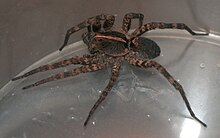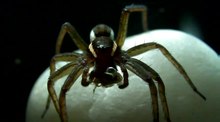Six-point hunting spider
| Six-point hunting spider | ||||||||||||
|---|---|---|---|---|---|---|---|---|---|---|---|---|

Six-point hunting spider ( Dolomedes triton ), female |
||||||||||||
| Systematics | ||||||||||||
|
||||||||||||
| Scientific name | ||||||||||||
| Dolomedes triton | ||||||||||||
| ( Walckenaer , 1837) |
The six-point hunting spider ( Dolomedes triton ) is a spider belonging to the family of hunting spiders (Pisauridae). Like the other types of river bank hunters ( Dolomedes ), this predominantly North American representative also has a remarkable and aquatic way of life.
features
Like all species of the genus, the six-point hunting spider can reach a body length that is comparatively large for spiders, which is 17 to 26 millimeters for females (in rare cases 30) and nine to thirteen millimeters for males. The weight of the adult spider can vary from one to one and a half grams. The basic color of the species is gray to brown, but also contains green tones. Like all species of the family and like many of the superfamily, the six-point hunting spider has well-developed eyes, which are almost the same size and are arranged in two rows one above the other. A property of all river bank hunters and thus also of the six-point hunting spider is the dense hair, which enables the spider to move on and under water. Air is trapped by this coat of hair, which is used for both swimming and breathing.
The female has a dark or green-brown carapace (back shield of the prosoma or front body) and two white longitudinal ligaments on the flanks of the carapace, the width of which varies depending on the individual. His opisthosoma is similar in color, but has a uniform green hue. Adjacent to the longitudinal ligaments of the carapace there are also ligaments on both sides of the opisthosoma. The name of the six-point hunting spider is derived from the clear white points, each set in pairs, the number of which can be six or eight. The legs are also colored green-brown and contain white spots or spots.
Apart from the shorter body length, the male is mostly similar to the female, but its white collateral ligaments appear wider on the carapace and opisthosoma.
Similar species
The six-point hunting spider is occasionally confused with larger wolf spiders (Lycosidae), or considered a species of this family, which also belongs to the superfamily Lycosoidea . However, like other hunting spiders, the six-point hunting spider differs from the species of wolf spiders by its eight eyes of equal size, the three tarsal claws here and the missing cribellum (an organ on the spinnerets in some spiders ).
Two other similar and closely related species are the Dolomedes striatus , which occurs in the same areas , but whose stripes , which are darker and clearer here, are a little higher up. and the much better known rimmed hunting spider ( Dolomedes fimbriatus ), which occurs in Europe , which means that both species cannot usually occur together.
Occurrence
The six-point hunting spider is mainly represented in the east of the United States and its range extends there from the east coast to the west to North Dakota and Texas . The northern limit of the range is in the US state of Maine in the northeast and in the Canadian province of British Columbia in the northwest, but there are individual records from Nunavut . The six-point hunting spider has also been detected in more humid areas of Central and South America .
Like all species of the river bank hunter spider genus, the water-loving six-point hunting spider can be found predominantly in the bank zones of still waters, but also in wooded areas including rainforests and bush forests as well as sea coasts as rural habitats and, in addition to ponds and lakes, also the bank areas of rivers and Stream.
Threat and protection
In their area of occurrence, the six-point hunting spider, unlike the rinded hunting spider ( Dolomedes fimbriatus ) and the rimmed water spider ( Dolomedes plantarius ), is common and is also the most common hunting spider in the United States. The IUCN does not assess their holdings and they do not enjoy any protection status.
Way of life
The six-point hunting spider is diurnal and can be found on land, at the edge of water, as well as on the surface of the water and, like all species of the genus, can move successfully there or by swimming on the surface, which is made possible by its dense body hair (see chapter " Features "). The six-point hunting spider can also submerge completely and remain under the surface of the water for up to 45 minutes by using the air stored in the hair as a source of oxygen.
The strategy of catching prey is also similar to that of other bank hunters . The spider is actively looking for prey, but can also remain motionless for hours and thus hunt as a stalker . A third hunting tactic used by the spider is to slap its forelegs on the surface of the water, which serves to attract potential prey. In order to locate prey animals, the spider uses surface tension waves triggered by these movements and can thus locate them up to a distance of 18 centimeters. If a target is within range, the spider also plunges up to 18 centimeters below the water and tries to grab the prey. These are then perceived by means of the sense of sight. Potential prey of the six-point hunting spider include aquatic arthropods or arthropods that have fallen on the water surface , but also tadpoles and small fish. Overall, the spider can consume five times its body weight through food in one day.
Although the riverside hunters' hunting strategy appears to be unique, hunting success is only 9% of all attempted capture. Perhaps one reason for this is that the spider also sees supposed prey, such as leaves and branches that have fallen on the water, and then tries to kill them. Such missed hunts make up 16% and are therefore much more likely than successes.
Phenology and reproduction

Adult specimens of the six-point hunting spider can be found all year round. As with many spiders, the male also performs a courtship . It is exposed to a high risk of cannibalism by the female if it is hungrier or if the male is courting incorrectly. Some time after mating, the female makes an egg cocoon and performs the self-sacrificing brood care typical of hunting spiders. The cocoon is carried by the female attached to the chelicerae (jaw claws). Shortly before hatching, the female creates a woven shelter and inserts the egg cocoon into it. It then remains and guards the cocoon and the hatched young animals until they become independent, which usually happens about a week after hatching.
Systematics
Walckenaer described the six-point hunting spider in 1837 as Lycosa triton and thus classified it as a wolf spider . Petrunkevitch placed the species in the genus Dolomedes for the first time in 1910, and the combination Dolomedes triton has been used throughout since Chamberlin and Ivie's work in 1946 . Other synonyms are:
- Dolomedes albiclavius Bishop , 1924
- Dolomedes major Banks , 1898
- Dolomedes spatulatus Chamberlin & Ivie , 1946
In addition to the nominate form, there is also the subspecies Dolomedes triton sexpunctatus ( Hentz , 1845).
gallery
Individual evidence
- ↑ a b c d e f g h i j k l m n Dolomedes triton (Walckenaer, 1837) on the website of "Animal Diversity Web" , accessed on February 17, 2020.
- ↑ a b c d e f g h i Richard A. Bradley: Common Spiders of North America , 1st edition, 2019, pp. 116/349, ISBN 9780520315310 .
- ↑ Eye position of the genus Dolomedes on the "BugGuide" website , accessed on February 17, 2020.
- ↑ Dolomedes stratus (Giebel, 1869) on the "BugGuide" website , accessed on February 17, 2020.
- ↑ a b c Dolomedes triton (Walckenaer, 1837) on the Global Biodiversity Information Facility website , accessed February 17, 2020.
- ↑ a b Dolomedes triton (Walckenaer, 1837) in the WSC World Spider Catalog , accessed on February 17, 2020.
literature
- Richard A. Bradley: Common Spiders of North America. 1st edition. 2019, ISBN 9780520315310 , pp. 116/349.
Web links
- Dolomedes triton in the World Spider Catalog
- Dolomedes triton (Walckenaer, 1837) on the Global Biodiversity Information Facility website.
- Dolomedes triton (Walckenaer, 1837) on the "Animal Diversity Web" website.
- Eye position of the genus Dolomedes on the website of "BugGuide".
- Dolomedes stratus (gable, 1869) on the "BugGuide" website.









